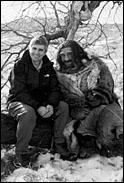A beastly look at ourselves
 Michael Bisson and an actor pal in Neanderthal garb share a moment on the set of Walking With Beasts.
Michael Bisson and an actor pal in Neanderthal garb share a moment on the set of Walking With Beasts. |
|
If archaeologist and anthropology professor Michael Bisson were as big and strong as Neanderthals apparently were, then he'd be able to make good use of the long wooden javelins and stone-tipped spears lying around in his office.
The prehistoric hunters employed these simple-looking tools to survive in their hostile environments, but since our supermarkets are well-stocked and large and wild creatures aren't terrorizing our city streets, Bisson just recreates them for study purposes.
"[Neanderthal] strength levels are the levels of today's highly professionally trained and steroid-pumped-up athletes. As strong or stronger. So they can manipulate things like this," says Bisson, wielding the javelin.
"Nevertheless, you can't throw this very far. If you throw it into a really big animal like a mammoth, it's only going to irritate the mammoth. So, they probably went after medium-sized animals and, even then, Neanderthals show a very high frequency of traumatic injury suggesting they'd been kicked and stomped. There was a lot of close encounter killing."
Bisson's expertise in the tools and weaponry of the middle Paleolithic period drew the attention of the producers of Walking with Beasts, a splashy big-budget documentary series currently airing on the BBC in Britain. Bisson crafted some period-appropriate stone tools and spears for the series and appears on camera in The Science of Walking with Beasts, a documentary on the making of Walking with Beasts.
The documentary takes a sophisticated look at the evolution of mammals from the period following the dinosaurs to the present day, using computer graphics and animatronics (remote-controlled robots) to simulate the mammals in a very realistic way.
It is reportedly the most expensive documentary ever made, at 4.2 million pounds, and is the sequel to the wildly popular BBC production, Walking with Dinosaurs.
Walking with Beasts looks like another hit -- 8.5 million viewers in the United Kingdom tuned in to the first episode. The series will air in Canada and in the U.S. in early December on the Discovery Channel.
Bisson says the discovery of fossils from the Pleistocene period (1.7 million to 10,000 years ago, otherwise known as the Ice Age) radically altered the way we understand how humans existed in the world.
"The fact that fossils existed was quite revolutionary. Biblical chronology and the whole notion of the earth having been created in 4004 BC precluded the possibility that there were prehistoric worlds in which animals came into existence and went extinct.
"There's basically one extinction accounted for in the Bible and that's the Biblical flood. You had to shoehorn all of the geological record into this period between Adam's creation and the Biblical flood and it just couldn't be done. As people began to discover fossils, they began to realize that the world had many pre-existing appearances and that animals had changed over time -- and, clearly, if animals had changed over time the possibility was there that humans had changed over time, too.
"The discovery and recognition of fossils was very important in beginning the process of linking humans to nature, humans as a part of nature as opposed to something created to rule over nature."
The last parts of the documentary deal with human evolution and try to isolate the "moment" in which the first hints of humanity could be detected. Fossils of the Australopithecus afarensis, or "southern ape from afar," have been found in Ethiopia, Tanzania and Kenya. The feature that sets them apart from other primates of the time is that they walked upright.
It is an early member of the human branch, but whether or not it is exactly on the human evolutionary line is a subject that is still being debated.
The documentary has already received some criticism, not so much from people who don't accept the body of knowledge surrounding evolution, but from scholars who fear that the series oversimplifies those theories. Bisson scoffs at such criticisms, saying that, unless the information is misleading or wrong, scholars should encourage popular science as part of their responsibility to educate the public.
"There's lots of misinformation out there about human evolution. I think it's part of our duty as scholars to contribute to public knowledge about important issues such as the origin of our species. You can't find a much more important issue than that."

